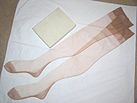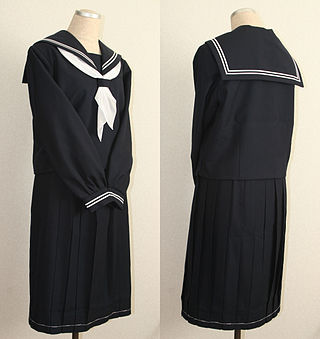
Japanese (sailor) school uniforms replicate the traditional English clothing piece that is heavily based on the British Royal Navy sailor uniform. These school uniforms were used in Japan in the late 19th century, replacing the traditional kimono. Today, school uniforms are common in many Japanese public and private schools. The Japanese word for this type of uniform is seifuku (制服).

Tights are a kind of cloth garment, most often sheathing the body from the waist to the toe tips with a tight fit, hence the name. They come in absolute opaque, opaque, sheer and fishnet styles — or a combination, such as the original concept of the American term pantyhose with sheer legs and opaque panty. A variant, toe tights, are tights with individual toes, in the same way toe socks are socks with individual toes.

Stockings are close-fitting, variously elastic garments covering the leg from the foot up to the knee or possibly part or all of the thigh. Stockings vary in color, design, and transparency. Today, stockings are primarily worn for fashion and aesthetics, usually in association with mid-length or short skirts.
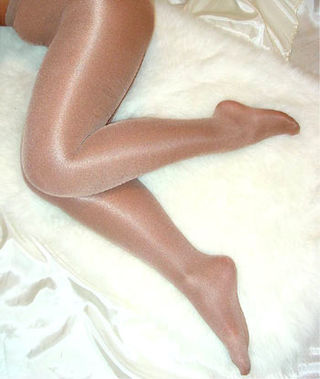
Pantyhose, sometimes also called sheer tights, are close-fitting legwear covering the wearer's body from the waist to the toes. Pantyhose first appeared on store shelves in 1959 for the advertisement of new design panties as a convenient alternative to stockings and/or control panties which, in turn, replaced girdles.

Shorts are a garment worn over the pelvic area, circling the waist and splitting to cover the upper part of the legs, sometimes extending down to the knees but not covering the entire length of the leg. They are called "shorts" because they are a shortened version of trousers, which cover the entire leg, but not the foot. Shorts are typically worn in warm weather or in an environment where comfort and airflow are more important than the protection of the legs.
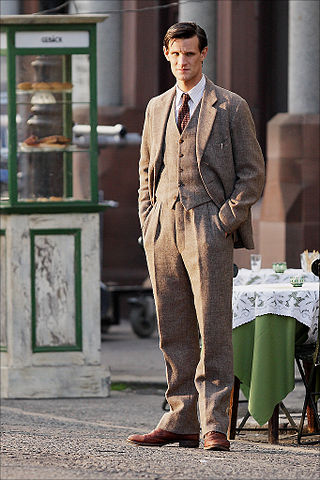
A suit, also called a lounge suit, business suit, dress suit, or formal suit is a set of clothes comprising a suit jacket and trousers of identical textiles generally worn with a collared dress shirt, necktie, and dress shoes. A skirt suit is similar, but with a matching skirt instead of trousers. It is currently considered semi-formal wear or business wear in contemporary Western dress codes, however when the suit was originally developed it was considered an informal or more casual option compared to the prevailing clothing standards of aristocrats and businessmen. The lounge suit originated in 19th-century Britain as sportswear and British country clothing, which is why it was seen as more casual than citywear at that time, with the roots of the suit coming from early modern Western Europe formal court or military clothes. After replacing the black frock coat in the early 20th century as regular daywear, a sober one-coloured suit became known as a lounge suit.
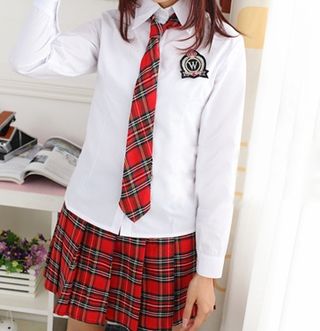
A Catholic school uniform in North America typically consists of a pleated and tartan skirt or jumper dress, Mary Jane or saddle shoes, a button-down shirt, and a sweater for girls, while boys' uniforms consist of a button-down shirt, a necktie, and dark pants. Actual school uniforms vary widely by location and individual school.
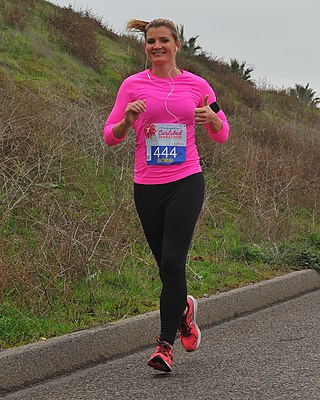
Leggings are several types of leg attire that have varied through the years. Modern usage from the 1960s onwards has come to refer to elastic close-fitting high-rise garments worn over the legs typically by women, such as leg warmers or tights. Usage from the 18th century refers to men's wear usually made of cloth or leather that is wrapped around the leg down to the ankle. In the 19th century, leggings usually referred to infants' leg clothing that were matched with a jacket, as well as leg-wrappings made of leather or wool and worn by soldiers and trappers. Leggings prominently returned to women's fashion in the 1960s, drawing from the form-fitting clothing of dancers. With the widespread adoption of the synthetic fibre Lycra and the rise in popularity of aerobics, leggings came to further prominence in the 1970s and 1980s, and eventually made their way into streetwear. Leggings are a part of the late 2010s into the 2020s athleisure fashion trend of wearing activewear outside sporting activities and in casual settings.

Mary Jane is an American term for a closed, low-cut shoe with one or more straps across the instep.

Fashion in the 1990s was defined by a return to minimalist fashion, in contrast to the more elaborate and flashy trends of the 1980s. One notable shift was the mainstream adoption of tattoos, body piercings aside from ear piercing and, to a much lesser extent, other forms of body modification such as branding.
Japanese street fashion refers to a number of styles of contemporary modern clothing in Japan. Created from a mix of both local and foreign fashion brands, Japanese street fashions tend to have their own distinctive style, with some considered to be extreme and imaginative, with similarities to the haute couture styles seen on European catwalks.

Bermuda shorts, also known as walk shorts or dress shorts, are a particular type of short trousers, worn as semi-casual attire by both men and women. The hem, which can be cuffed or un-cuffed, is around 1 inch (2.5 cm) above the knee.

Fashion of the 1960s featured a number of diverse trends, as part of a decade that broke many fashion traditions, adopted new cultures, and launched a new age of social movements. Around the middle of the decade, fashions arising from small pockets of young people in a few urban centers received large amounts of media publicity, and began to heavily influence both the haute couture of elite designers and the mass-market manufacturers. Examples include the mini skirt, culottes, go-go boots, and more experimental fashions, less often seen on the street, such as curved PVC dresses and other PVC clothes.

Fashion in the 1970s was about individuality. In the early 1970s, Vogue proclaimed "There are no rules in the fashion game now" due to overproduction flooding the market with cheap synthetic clothing. Common items included mini skirts, bell-bottoms popularized by hippies, vintage clothing from the 1950s and earlier, and the androgynous glam rock and disco styles that introduced platform shoes, bright colors, glitter, and satin.

Informal wear or undress, also called business wear, corporate/office wear, tenue de ville or dress clothes, is a Western dress code for clothing defined by a business suit for men, and cocktail dress or pant suit for women. On the scale of formality, it is considered less formal than semi-formal wear but more formal than casual wear. Informal or undress should not be confused with casual wear such as business casual or smart casual; most situations calling for “informal wear” will usually tolerate casual dress to varying extents.

The most characteristic North American fashion trend from the 1930s to 1945 was attention at the shoulder, with butterfly sleeves and banjo sleeves, and exaggerated shoulder pads for both men and women by the 1940s. The period also saw the first widespread use of man-made fibers, especially rayon for dresses and viscose for linings and lingerie, and synthetic nylon stockings. The zipper became widely used. These essentially U.S. developments were echoed, in varying degrees, in Britain and Europe. Suntans became fashionable in the early 1930s, along with travel to the resorts along the Mediterranean, in the Bahamas, and on the east coast of Florida where one can acquire a tan, leading to new categories of clothes: white dinner jackets for men and beach pajamas, halter tops, and bare midriffs for women.

A garter is an article of clothing comprising a narrow band of fabric fastened about the leg to keep up stockings. In the eighteenth to twentieth centuries, they were tied just below the knee, where the leg is most slender, to keep the stocking from slipping. The advent of elastic has made them less necessary from this functional standpoint, although they are still often worn for fashion. Garters have been widely worn by men and women, depending on fashion trends.
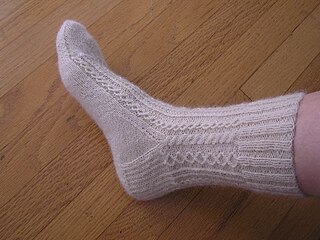
A sock is a piece of clothing worn on the feet and often covering the ankle or some part of the calf. Some types of shoes or boots are typically worn over socks. In ancient times, socks were made from leather or matted animal hair. In the late 16th century, machine-knit socks were first produced. Until the 1800s, both hand-made and machine-knit socks were manufactured, with the latter technique becoming more common in the 19th century, and continuing until the modern day.
The Medieval period in England is usually classified as the time between the fall of the Roman Empire to the beginning of the Renaissance, roughly the years AD 410–1485. For various peoples living in England, the Anglo-Saxons, Anglo-Danes, Normans and Britons, clothing in the medieval era differed widely for men and women as well as for different classes in the social hierarchy. The general styles of Early medieval European dress were shared in England. In the later part of the period, men's clothing changed much more rapidly than women's styles. Clothes were very expensive, and both men and women were divided into social classes by regulating the colors and styles that various ranks were permitted to wear. In the early Middle Ages, clothing was typically simple and, particularly in the case of lower-class peoples, served only basic utilitarian functions such as modesty and protection from the elements. As time went on the advent of more advanced textile techniques and increased international relations, clothing gradually got more and more intricate and elegant, even with those under the wealthy classes, up into the renaissance.

A fashion boot is a boot worn for reasons of style or fashion. The term is usually applied to women's boots. Fashion boots come in a wide variety of styles, from ankle to thigh-length, and are used for casual, formal, and business attire. Although boots were a popular style of women's footwear in the 19th century, they were not recognized as a high fashion item until the 1960s. They became widely popular in the 1970s and have remained a staple of women's winter wardrobes since then.




















